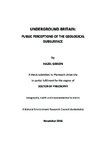Underground Britain: public perceptions of the geological subsurface
| dc.contributor.supervisor | Stewart, Iain Simpson | |
| dc.contributor.author | Gibson, Hazel Laura | |
| dc.contributor.other | School of Geography, Earth and Environmental Sciences | en_US |
| dc.date.accessioned | 2017-03-02T09:57:39Z | |
| dc.date.available | 2017-03-02T09:57:39Z | |
| dc.date.issued | 2017 | |
| dc.date.issued | 2017 | |
| dc.identifier | 236443 | en_US |
| dc.identifier.uri | http://hdl.handle.net/10026.1/8578 | |
| dc.description | For access to the full interview transcripts and photographs from Appendix 2 please contact the author: hazel.gibson@plymouth.ac.uk | en_US |
| dc.description.abstract |
Geoscience operates at the boundary between two worlds; the visible and the invisible. Increasingly, new geological technologies such as hydraulic fracturing, carbon capture and storage (CCS) and radioactive waste disposal are drawing the public’s attention to the ‘invisible’ world of the geological subsurface. This presents unique communication challenges because these technologies exist in a realm that can never be physically seen. This thesis addresses this issue by examining the psychological perceptions of residents in three villages in the south west of England. A representative sample from each village was qualitatively interviewed and mental models were constructed from the resultant data using the ‘mental models’ technique (Morgan et al, 2002). The mental models were then quantitatively tested using a questionnaire to assess the perceptions that a broader sample of the residents of these locations hold towards the geological subsurface. The results from the mental models assessment identified the principal perceptions held by the majority of the public surveyed. In particular, the study revealed the connection between the visible surface and the invisible subsurface and how different participants engaged with that boundary; choosing either a geoscience-centric or an anthropocentric approach to penetrating the surface. These approaches utilised by non-experts differed from those employed by the experts, who used a regionally specific geoscience-centric approach to visualising the subsurface. The work provides an important empirical baseline from which to develop a science-led strategy to engage the general public with new technologies and to increase our understanding of the more broadly held conceptions of the invisible subsurface. | en_US |
| dc.language.iso | en | |
| dc.publisher | University of Plymouth | |
| dc.subject | Geocognition | en_US |
| dc.subject | Geocommunication | en_US |
| dc.subject | Geological subsurface | en_US |
| dc.subject | Geology | en_US |
| dc.subject | Geoscience | en_US |
| dc.subject | Geoscience cognition | en_US |
| dc.subject | Geoscience communication | en_US |
| dc.subject | Mental models | en_US |
| dc.subject | Public perception | en_US |
| dc.subject | Public understanding of science | en_US |
| dc.subject | Devon | en_US |
| dc.subject | Cornwall | en_US |
| dc.subject | Cognition | en_US |
| dc.subject | Science communication | en_US |
| dc.subject.classification | PhD | en_US |
| dc.title | Underground Britain: public perceptions of the geological subsurface | en_US |
| dc.type | Thesis | |
| plymouth.version | publishable | en_US |
| dc.identifier.doi | http://dx.doi.org/10.24382/376 | |
| dc.provenance | An issue reported on 25.06.2018 re problem downloading this large file (PU274456). Requested file to compress but no response received from author. | |
| dc.rights.embargoperiod | No embargo | en_US |
| dc.type.qualification | Doctorate | en_US |
| rioxxterms.funder | Natural Environment Research Council | en_US |
| rioxxterms.identifier.project | 1222755 | en_US |
| rioxxterms.version | NA | |
| plymouth.orcid.id | 0000-0003-1496-0996 | en_US |
Files in this item
This item appears in the following Collection(s)
-
01 Research Theses Main Collection
Research Theses Main


